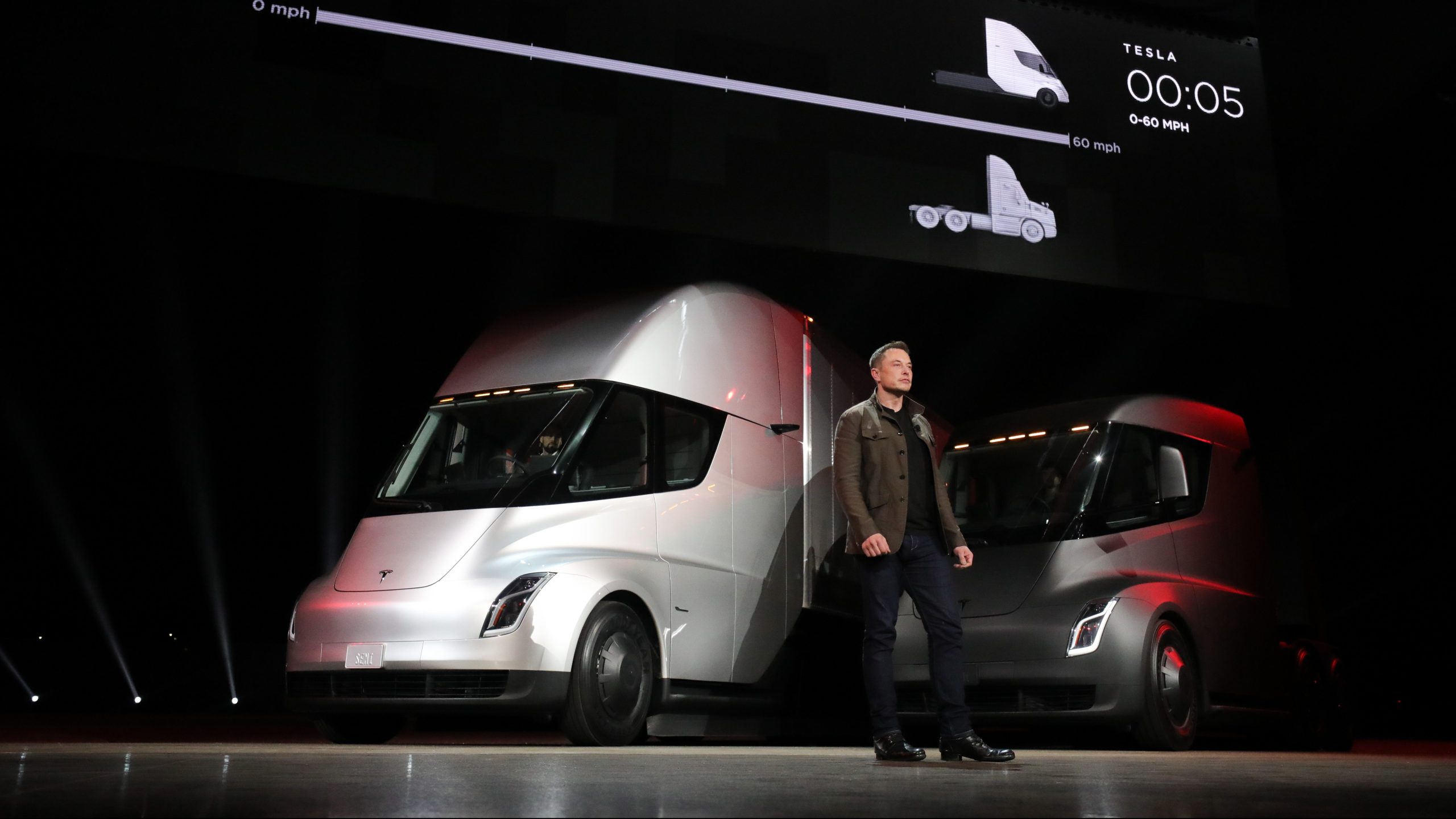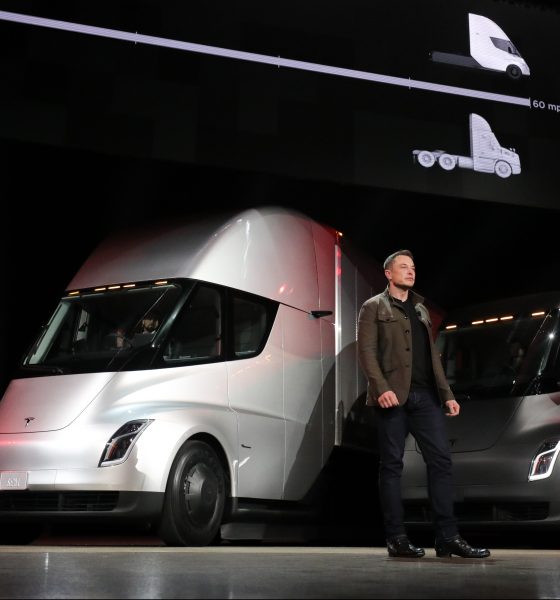

News
A Tesla Semi with structural batteries and 620 miles of range is a haymaker against trucking emissions
The Tesla Semi may be requiring a lot of patience among its reservation holders, but it appears that the all-electric Class 8 long-hauler will be well worth the wait. While speaking at the European Battery Conference organized by the Federal Ministry of Economics, Elon Musk remarked that the Tesla Semi will be equipped with a structural battery pack. This, together with other optimizations, should allow the Tesla Semi to have a range of up to 620 miles in the future.
“Getting a range of 500 km is I think, quite easy. And this is assuming a truck that is pulling a load of something in the order of 40 metric tons. So that’s a heavy truck. For long-range trucking, up to, we think, easily 800 kilometers, and we see a path over time, to get to about 1,000 kilometers of range. We think this is going to be extremely competitive and compelling to trucking companies,” Musk said.
The Tesla Semi’s initial range of 300-500 miles per charge is no joke, but it does give the impression that the Class 8 long-hauler is best used for short or medium routes. With a 620-mile range, however, things become very different. Together with its low operating costs, stellar safety systems, as well as built-in driver-assist features like Convoy Mode, the Tesla Semi could very well be a haymaker against the emissions of the trucking industry.
The trucking industry is among the biggest culprits in the transportation sector’s overall emissions. Following the unveiling of the Tesla Semi back in 2017, the Environmental Defense Fund published a post stating that the transportation sector accounts for 7% of total fine particulate matter globally. Commonly known as soot, particulate matter has been linked to several diseases such as cancer, heart attacks, and strokes. Freight trucks produce nearly half of the transportation sector’s total fine particulate matter.
There is no doubt that a shift to electric trucks would benefit the environment and humanity as a whole. Unfortunately, battery-electric trucks have been constrained by range so far. Even vehicles made by veteran truckers like the eCascadia are only able to travel a measly 250 miles per charge. That makes battery-electric trucks limited in their use, despite their environmental benefits. Even the Tesla Semi’s initial iteration, which was announced with 300-500 miles of range per charge, is not comparable to the range of diesel long-haulers, which are fitted with 200-gallon tanks and are capable of running over 1,000 miles with a full tank.
Things become very different with a battery-electric truck that is capable of traveling 620 miles between charging sessions. In the United States, semi truck drivers are mandated by law to drive no more than 11 hours per day with a 14-hour work day cap before they are required to rest. At highway speeds, this translates to drivers covering about 600-650 miles per shift. Considering Elon Musk’s recent statements about the Semi, it appears that Tesla is improving its Class 8 truck to such a degree that it would be a compelling alternative even to long-range diesel and gas semis.
The trucking market is pretty much dictated by the businesses that are dependent on it. With this in mind, there is a good chance that businesses using trucks for their operations would shift to battery-electric trucks once they offer more advantages compared to their traditional counterparts. In the Tesla Semi’s case, the low operating costs, better performance, and safety improvements are already there. And with 620 miles of range, businesses will likely find very little reason to stick with fossil fuel-powered trucks.

Elon Musk
Tesla AI Head says future FSD feature has already partially shipped

Tesla’s Head of AI, Ashok Elluswamy, says that something that was expected with version 14.3 of the company’s Full Self-Driving platform has already partially shipped with the current build of version 14.2.
Tesla and CEO Elon Musk have teased on several occasions that reasoning will be a big piece of future Full Self-Driving builds, helping bring forth the “sentient” narrative that the company has pushed for these more advanced FSD versions.
Back in October on the Q3 Earnings Call, Musk said:
“With reasoning, it’s literally going to think about which parking spot to pick. It’ll drop you off at the entrance of the store, then go find a parking spot. It’s going to spot empty spots much better than a human. It’s going to use reasoning to solve things.”
Musk said in the same month:
“By v14.3, your car will feel like it is sentient.”
Amazingly, Tesla Full Self-Driving v14.2.2.2, which is the most recent iteration released, is very close to this sentient feeling. However, there are more things that need to be improved, and logic appears to be in the future plans to help with decision-making in general, alongside other refinements and features.
On Thursday evening, Elluswamy revealed that some of the reasoning features have already been rolled out, confirming that it has been added to navigation route changes during construction, as well as with parking options.
He added that “more and more reasoning will ship in Q1.”
🚨 Tesla’s Ashok Elluswamy reveals Nav decisions when encountering construction and parking options contain “some elements of reasoning”
More uses of reasoning will be shipped later this quarter, a big tidbit of info as we wait v14.3 https://t.co/jty8llgsKM
— TESLARATI (@Teslarati) January 9, 2026
Interestingly, parking improvements were hinted at being added in the initial rollout of v14.2 several months ago. These had not rolled out to vehicles quite yet, as they were listed under the future improvements portion of the release notes, but it appears things have already started to make their way to cars in a limited fashion.
Tesla Full Self-Driving v14.2 – Full Review, the Good and the Bad
As reasoning is more involved in more of the Full Self-Driving suite, it is likely we will see cars make better decisions in terms of routing and navigation, which is a big complaint of many owners (including me).
Additionally, the operation as a whole should be smoother and more comfortable to owners, which is hard to believe considering how good it is already. Nevertheless, there are absolutely improvements that need to be made before Tesla can introduce completely unsupervised FSD.
Elon Musk
Tesla’s Elon Musk: 10 billion miles needed for safe Unsupervised FSD
As per the CEO, roughly 10 billion miles of training data are required due to reality’s “super long tail of complexity.”

Tesla CEO Elon Musk has provided an updated estimate for the training data needed to achieve truly safe unsupervised Full Self-Driving (FSD).
As per the CEO, roughly 10 billion miles of training data are required due to reality’s “super long tail of complexity.”
10 billion miles of training data
Musk comment came as a reply to Apple and Rivian alum Paul Beisel, who posted an analysis on X about the gap between tech demonstrations and real-world products. In his post, Beisel highlighted Tesla’s data-driven lead in autonomy, and he also argued that it would not be easy for rivals to become a legitimate competitor to FSD quickly.
“The notion that someone can ‘catch up’ to this problem primarily through simulation and limited on-road exposure strikes me as deeply naive. This is not a demo problem. It is a scale, data, and iteration problem— and Tesla is already far, far down that road while others are just getting started,” Beisel wrote.
Musk responded to Beisel’s post, stating that “Roughly 10 billion miles of training data is needed to achieve safe unsupervised self-driving. Reality has a super long tail of complexity.” This is quite interesting considering that in his Master Plan Part Deux, Elon Musk estimated that worldwide regulatory approval for autonomous driving would require around 6 billion miles.
FSD’s total training miles
As 2025 came to a close, Tesla community members observed that FSD was already nearing 7 billion miles driven, with over 2.5 billion miles being from inner city roads. The 7-billion-mile mark was passed just a few days later. This suggests that Tesla is likely the company today with the most training data for its autonomous driving program.
The difficulties of achieving autonomy were referenced by Elon Musk recently, when he commented on Nvidia’s Alpamayo program. As per Musk, “they will find that it’s easy to get to 99% and then super hard to solve the long tail of the distribution.” These sentiments were echoed by Tesla VP for AI software Ashok Elluswamy, who also noted on X that “the long tail is sooo long, that most people can’t grasp it.”
News
Tesla earns top honors at MotorTrend’s SDV Innovator Awards
MotorTrend’s SDV Awards were presented during CES 2026 in Las Vegas.

Tesla emerged as one of the most recognized automakers at MotorTrend’s 2026 Software-Defined Vehicle (SDV) Innovator Awards.
As could be seen in a press release from the publication, two key Tesla employees were honored for their work on AI, autonomy, and vehicle software. MotorTrend’s SDV Awards were presented during CES 2026 in Las Vegas.
Tesla leaders and engineers recognized
The fourth annual SDV Innovator Awards celebrate pioneers and experts who are pushing the automotive industry deeper into software-driven development. Among the most notable honorees for this year was Ashok Elluswamy, Tesla’s Vice President of AI Software, who received a Pioneer Award for his role in advancing artificial intelligence and autonomy across the company’s vehicle lineup.
Tesla also secured recognition in the Expert category, with Lawson Fulton, a staff Autopilot machine learning engineer, honored for his contributions to Tesla’s driver-assistance and autonomous systems.
Tesla’s software-first strategy
While automakers like General Motors, Ford, and Rivian also received recognition, Tesla’s multiple awards stood out given the company’s outsized role in popularizing software-defined vehicles over the past decade. From frequent OTA updates to its data-driven approach to autonomy, Tesla has consistently treated vehicles as evolving software platforms rather than static products.
This has made Tesla’s vehicles very unique in their respective sectors, as they are arguably the only cars that objectively get better over time. This is especially true for vehicles that are loaded with the company’s Full Self-Driving system, which are getting progressively more intelligent and autonomous over time. The majority of Tesla’s updates to its vehicles are free as well, which is very much appreciated by customers worldwide.








